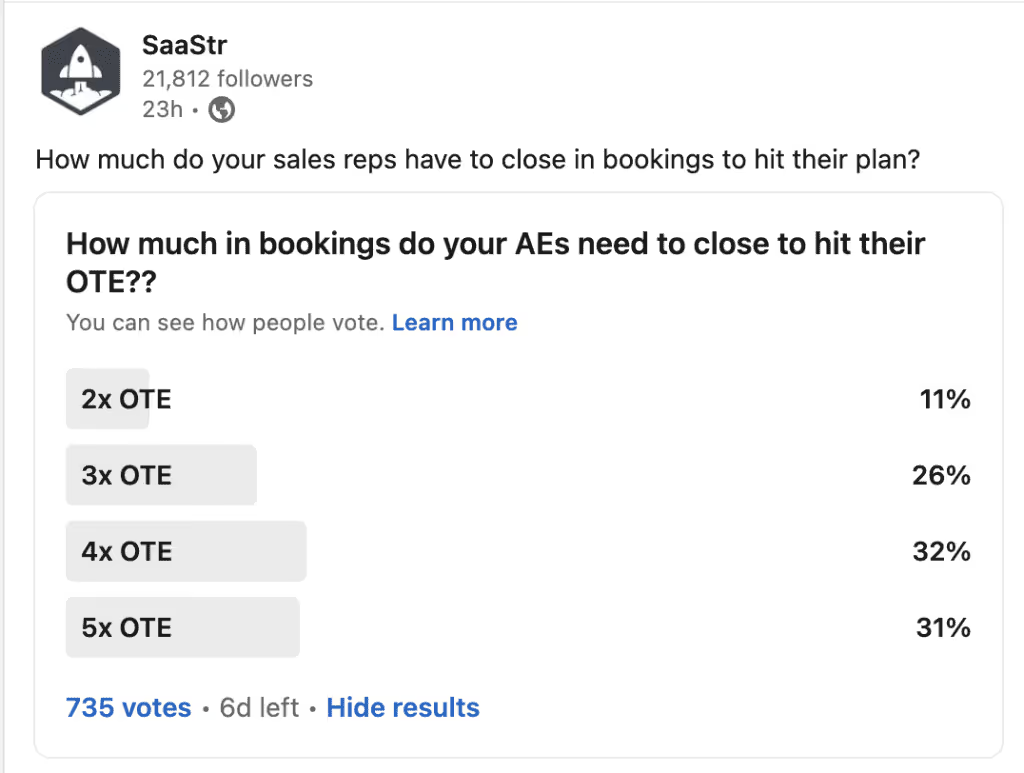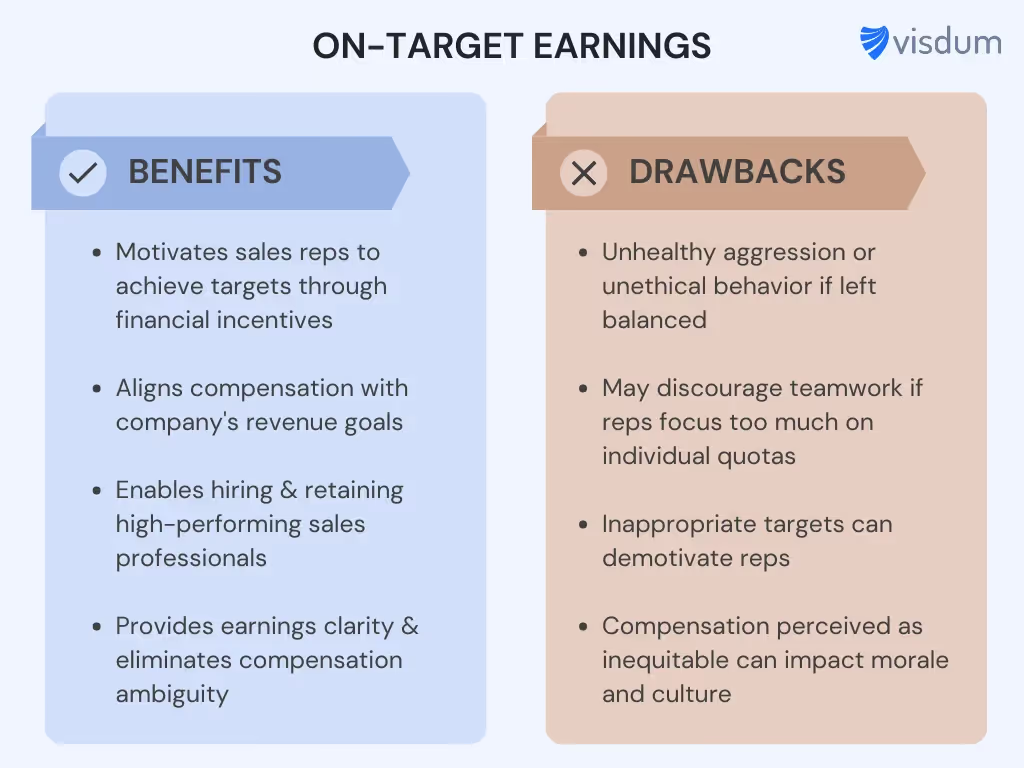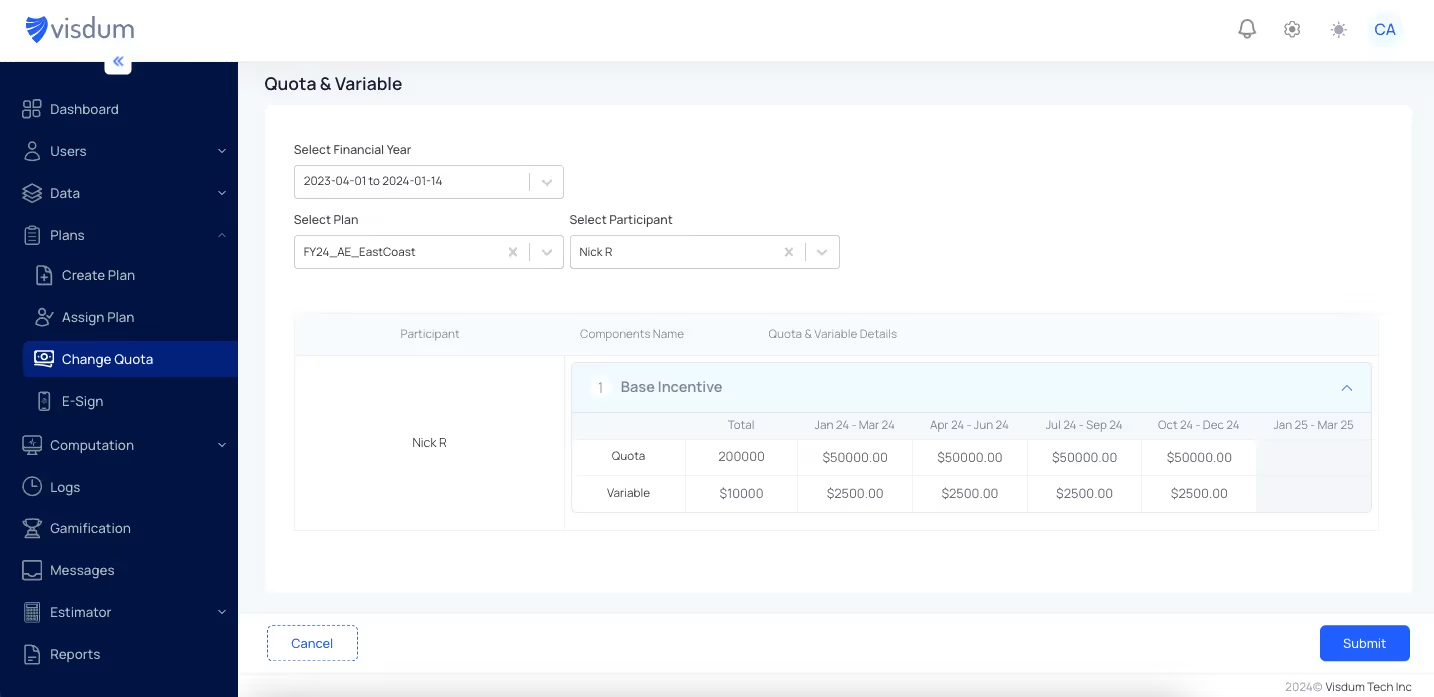What is OTE (on-target-earnings)? OTE Meaning and Usage

When I first heard the term OTE in a sales job offer, I was intrigued—and a little confused. “On-target earnings” sounded like a big number, but I had no idea how realistic it was, or how much of it actually went to sales reps.
Since then, I’ve worked with dozens of sales teams and analyzed a plethora of comp plans at Visdum (Easiest-to-Use Sales Commission Software btw), and here’s what I’ve learnt: OTE is more than a number—it’s a lens into how a company values performance.
In this guide, I’ll break down what OTE really means, how it works, and—most importantly—what you should watch out for when evaluating a compensation plan as a rep. Whether you’re a job seeker trying to understand your earning potential or a sales leader designing comp plans, you’ll learn:
- How OTE is calculated (with examples)
- Why OTE can be motivating—or misleading
- How to negotiate your OTE and ask the right questions
- What realistic OTE benchmarks look like in SaaS and tech
If you’ve ever wondered why some sales roles advertise $250K+ income potential, this post will show you exactly what that 'potential' means—and how to make it work for you.
What is OTE?
On-target earnings (OTE) is a compensation metric that represents the total earnings a sales professional can achieve if they meet 100% of their sales quota or targets. It is the sum total of the base compensation and the total incentive pay (sales commissions, bonuses, etc.) at 100% target completion.
OTE = Base Salary + Variable Pay at 100% Quota
- Base Salary: Your fixed annual pay.
- Variable Pay: Commissions, bonuses, or other variable compensation tied to hitting performance goals.
💡 Quick Example:
If a sales role offers a $60,000 base and a $40,000 target commission, your OTE is $100,000. But—and this is key—that full amount is only earned if you hit 100% of your sales quota.
On-Target Earnings represent the maximum that you or I could 'technically' earn if we are to hit 100% of our sales goals. This often leads to employers advertising jobs with the OTE figure, whereas income reality might be completely different.
Why OTE Matters in SaaS Sales
In SaaS companies with recurring revenue models, OTE isn't just a comp metric, rather, it's how companies attract, motivate, and retain high-performing sales reps. Job listings often advertise “$100K OTE” or “$200K OTE,” but here's the part that doesn’t always get mentioned:
Most reps won’t hit 100% of quota every quarter.
That’s not always because they underperform—it can also be because the quotas themselves are overly aggressive or the sales cycle is long.
Must Read: What is the right (for you) quota to OTE Ratio?
How Sales Quotas and OTE Are Connected: Quota-to-OTE Ratio
Sales quotas are typically set based on the OTE number. The relationship between these two figures is called the Quota-to-OTE ratio. A good rule of thumb in SaaS is:
To earn your full OTE, you’ll likely need to close 4–5x that amount in revenue.
So if your OTE is $100,000, your quota might be $400,000–$500,000 in annual new business or ARR. This is how companies align pay with revenue goals—and it’s why understanding your quota is just as important as understanding your comp plan. Here's some data supporting this:

Source: SaaStr
OTE serves as a powerful motivator for SaaS sales teams, encouraging them to prioritize activities that drive new customer acquisition and existing customer retention/expansion. By setting achievable yet challenging OTE targets, SaaS companies can foster a high-performance sales culture laser-focused on revenue growth.
How is OTE related to Pay Mix?
In sales compensation, OTE and pay mix are closely interlinked concepts that feed into each other. The pay mix determines what proportion of the OTE comes from base salary versus variable components.

The pay mix refers to the ratio between fixed base pay and incentive/variable pay like commissions and bonuses. A 70/30 pay mix means 70% base salary and 30% variable, while a more aggressive 50/50 split allocates an equal weightage to each component.
This pay mix has a direct impact on the structure and motivating nature of the OTE:
- A higher base salary percentage lowers risk/volatility but provides less motivation.
- Higher variable components increase motivation, but also create more risk and instability.
For example, a $120,000 OTE could be split:
- Standard Split-> 70/30: $84,000 base salary + $36,000 variable
- Aggressive Split-> 50/50: $60,000 base salary + $60,000 variable
SaaS companies leverage different pay mixes across sales roles based on factors like:
- Role's quota difficulty and performance expectations
- Typical ramp/sales cycle for that product
- Market pay benchmarks for attracting/retaining talent
- Company's cash flow and risk preferences
By carefully balancing the pay mix, sales leaders can design OTE packages that attract top reps, drive the desired behaviors, and align with the company's overall compensation philosophy.
Also read: A Guide To Setting Sales Quotas That Motivate Your Team
How to Calculate OTE? (On-Target Earnings)
The calculation of OTE in SaaS sales compensation plans typically involves two components: the annual base salary and the annual commission earned at 100% quota attainment.
The basic formula for OTE is: OTE= Annual Base Salary + Annual Commission at 100% Quota Attainment

How Does OTE Work in Real Life?
Given below are example OTE breakdowns for junior vs. senior sales roles:
Sales Representative OTE
For sales roles like account executives (AEs) or sales development representatives (SDRs), the OTE calculation includes a base pay and a commission rate tied to the sales quota. For example, if an AE has a base salary of $60,000 and a 10% commission rate on a $500,000 quota, their OTE would be:
Base Salary: $60,000
Commission at 100% Quota Attainment (10% of $500,000): $50,000
OTE: $60,000 + $50,000 = $110,000
Real Data: According to Glassdoor, the average base salary for a sales representative is $57K - $104K/yr and the average additional pay is $56K - $105K/yr leading to an OTE of around $113,000 to $210,000. This figure varies on years of experience, industry, etc. For example, the highest OTEs are found in enterprise tech sales.
Executive Sales OTE
Executive sales roles like sales managers or directors may have a different OTE structure with a higher base salary component and a bonus based on team performance metrics or company goals.
For instance, a sales manager with an annual base salary of $120,000 and a potential $30,000 bonus for achieving team targets would have an OTE of $150,000.
The actual total earnings of a SaaS sales professional may vary from the OTE based on their individual quota attainment and performance. OTE simply means the amount of money a sales rep can expect when he is "100% on target". Earnings can surpass OTE when sales reps exceed their quota.
Practical OTE Examples (With Numbers)
To better understand how OTE works across different roles (not just sales), let's look at some examples from typical SaaS organizations.
On-Target Earnings For Account Executives
For account executives in SaaS sales, a typical OTE structure could look like:
Base Salary: $60,000
Commission Rate: 10% of closed deals
Quota: $1,000,000 in Annual Contract Value (ACV
With this compensation plan, if the account executive achieves their $1M quota, their OTE calculates as:
Base: $60,000
Commission (10% of $1M): $100,000
OTE: $160,000
Higher quotas increase potential OTE. For example, a $1.5M quota at 10% commission yields a $210,000 OTE.
SaaS companies need to carefully balance quota difficulty with lucrative OTE to attract and motivate closers capable of selling their product.
On-Target Earnings For Sales Development Representatives
For an entry-level role like a sales development rep (SDR), the OTE tends to be lower with a higher base/variable split:
Base: $45,000
Commission: $10,000 (at 100% of qualified leads quota)
OTE: $55,000
This accounts for the ramp time required for new SDRs while still providing a path to higher earnings as they become fully productive.
On-Target Earnings For Director of Marketing
For a non-sales role like a marketing leader, the OTE model is often more heavily weighted towards base salary:
Base: $130,000
Bonus: 15% of base ($19,500) for achieving marketing goals
OTE: $149,500
This ties variable pay to their ability to hit lead generation numbers that fuel the sales funnel while providing a higher base compensation.
The ideal OTE model varies across roles, accounts for relevant performance metrics, and balances salaries vs variable pay appropriately.
On-Target Earnings For Sales Managers
As a sales leader, this manager's OTE is heavily weighted towards a base salary to account for their oversight and leadership responsibilities.
OTE: $132,000
Base Salary: $90,000
Performance Bonus: $42,000 (for achieving team quota of $5M ARR)
However, their annual bonus potential of $42,000 ties a significant portion of their compensation to the sales team's ability to hit an aggressive $5M annual recurring revenue (ARR) number.
On-Target Earnings For Customer Success Managers
Customer success roles are critical for SaaS revenue retention.
OTE: $80,000
Base: $65,000
Bonus: $15,000 (for under 10% annual churn)
This compensation model incentivizes low annual churn rates through a $15,000 bonus, while providing a solid $65,000 base salary. Maintaining and expanding the customer base impacts the OTE.
These examples highlight how OTE is adapted for different roles, aligning incentives with the desired behaviors and outcomes for each function.
The Role of OTE in Job Offers
When hiring for sales roles in the SaaS industry, OTE plays a pivotal role in job offers and negotiations. Here's how:
- OTE Salary is prominently featured in job descriptions and postings to attract top sales talent by showcasing the potential earnings.
- During the hiring process, candidates evaluate OTE as a key component of the total compensation package being offered.
- SaaS companies use competitive OTE offers to hire the best talent, especially for roles with longer sales cycles.
- The pay mix (split between base salary and variable commission) impacts the OTE structure and helps set realistic OTE targets.
- Higher OTE targets align with more aggressive sales goals and quotas for closers and account executives.
By clearly communicating the OTE upfront, SaaS organizations can ensure transparency, manage candidate expectations accurately, and position themselves as attractive employers in the competitive sales job market.
Pro Tip: Always Ask These Questions About OTE
Before you accept any sales job with OTE-based compensation, ask:
- What percentage of reps actually hit quota?
- How often is OTE realistically achieved in this role?
- What’s the average deal size, and how long is the sales cycle?
- Is the quota based on new ARR, renewals, upsells, or a mix?
These insights will help you determine whether that flashy OTE number is realistic or just a recruiting hook. Based on these figures, negotiate your actual OTE- for example, longer sale cycles and smaller average deal size probably means you scope for closing deals is limited, so get your base salary increased.
A common misconception new sales reps often have is that OTE is the amount that they are going to make, whereas in reality, even with your utmost efforts it might not be possible to hit that number if the compensation system is designed against its.
Benefits and Drawbacks of OTE
Like any compensation model, OTE has its pros and cons that SaaS sales leaders should carefully evaluate:

Striking the right balance through best practices in OTE modeling, transparent communication, and continuous monitoring is key for SaaS sales organizations.
👉 Must Read: How to use SPIFFs to motivate your sales floor
How to Audit for OTE
Regularly auditing and optimizing your OTE models is crucial for SaaS companies to ensure their sales compensation plans remain competitive, motivating, and aligned with business goals.
Here are some best practices:
- Benchmark your OTE ranges against industry standards and competitors to attract top sales talent.
- Analyze quota attainment and payout data to identify misaligned OTE targets. OTE should be achievable.
- Gather feedback from sales reps on the motivating impact of the current OTE structure.
- Model different compensation structures to understand their impact on sales behavior.
- Leverage compensation planning software to accurately forecast OTE costs.
- Continuously monitor and adjust OTE as your product, pricing, and go-to-market evolve.
An objective internal audit combined with external benchmarking allows sales leaders to course-correct OTE before it negatively impacts sales performance, employee motivation, or causes talent attrition.
OTE Glossary: OTE Terms You Need to Know
Like any domain, OTE modeling and sales compensation planning has its own set of key terms. Understanding this glossary will help ensure you're fully conversant:
- Base Salary/Pay: The fixed cash component of a rep's total compensation, paid regardless of performance.
- Commission Rate: Percentage of a deal's value paid to the rep as incentive compensation.
- Commission Structure: The specifics of how commissions are calculated based on attainment of quotas or metrics.
- Pay Mix: The ratio between base pay and variable/incentive pay components.
- Quota: Revenue or other performance metric target that reps must achieve.
- Quota Attainment: Percentage of assigned quota achieved by a rep over a period.
- On-Target Earnings (OTE): Total earning potential when 100% of quota is attained.
- Average Attainment: Avg % of quota a rep profile achieves - used to set realistic OTEs.
- Accelerators/Decelerators: Commission rate adjustments for over or under-achievement.
- Ramp Time: Period for new hires to reach full productivity factored into OTE.
Explore our collection of commonly used terminologies and definitions, the Visdum Sales Compensation Glossary 💡
Mastering these terms will enable you to design transparent, motivating OTE models that supercharge your SaaS sales team!
Leveraging OTE Modeling with Visdum's Sales Compensation Software
While OTE is a powerful tool for motivating and retaining top SaaS sales talent, managing compensation plans can quickly become complex as your company scales. This is where Visdum's sales commission software can be a game-changer.

With Visdum, you can:
- Design customized OTE models tailored to your sales roles and processes
- Automate commission calculations for accurate real-time OTE visibility
- Provide transparency to reps on precisely how their efforts impact earnings
- Model scenarios to optimize pay mix, quotas, accelerators, and more
- Integrate seamlessly with your CRM for data integrity
- Analyze payout metrics to continually refine your compensation plans
- Spend less time on manual comp plan administration
By leveraging Visdum's intuitive platform, SaaS companies can ensure their OTE programs remain competitive, drive the right behaviors, and allow sales teams to focus on closing deals rather than decoding compensation.
Ready to see the power of data-driven OTE modeling? Request a demo with Visdum today!
Frequently Asked Questions About OTE (On-Target Earnings)
What does OTE mean in sales?
OTE, or On-Target Earnings, is the total amount a sales rep can earn if they hit 100% of their sales quota. It includes both the base salary and the commission or bonus tied to performance. In simple terms, it’s what you should make if you do your job well.
💬 From my own experience, OTE helps set realistic earning expectations—but only if you understand how quotas are set.
How is OTE calculated?
Here’s how I typically break it down:
OTE = Base Salary + Variable Pay at 100% Quota
Let’s say your base is $60,000, and you earn 10% commission on a $500,000 quota. That’s $50,000 in commission, so your OTE is $110,000.
Does OTE get paid monthly?
Not exactly. While your base salary is usually paid bi-weekly or monthly, the commission/bonus portion of OTE is often paid monthly, quarterly, or even annually, depending on the company’s comp plan.
📌 Always ask how frequently variable pay is paid out.
What does “$100K–$200K OTE” in a job posting mean?
It usually means the base salary could be between $100K and $200K, plus additional commission or bonus potential. But sometimes it reflects total comp including base and variable. Clarify during interviews whether that figure includes base or is on top of it.
Is base salary included in OTE?
Yes, it is. OTE = base salary + incentive pay. So if a job offers a $70K base and a $30K commission target, your OTE is $100K.
What does 150K OTE mean?
It means that if you hit your sales targets, you’ll earn up to $150,000 total compensation—including your base and commissions. For example, that could be $90K base + $60K variable.
What does 120K OTE mean?
A 120K OTE means your total expected earnings at 100% quota would be $120,000. That could be $70K base + $50K commission, or a similar mix depending on the plan.
What does 200K OTE mean?
A 200K OTE is common for senior sales roles in tech, like Enterprise AEs or Strategic Account Managers. It often involves $100K–$120K base plus commission on large, complex deals.
What’s a “good” OTE percentage?
It depends on the industry, but in SaaS:
🔢 A 10–20% commission rate on quota is typical.
So if your quota is $1M, a good OTE could be $100K–$200K. What matters most is how achievable the quota is and how many reps are actually hitting it.
What is the average SaaS sales quota?
In my experience, SaaS quotas range from:
- $500K–$1.5M for SMB or Mid-Market AEs
- $1.5M–$3M+ for Enterprise reps
It depends on deal size, sales cycle, territory, and whether the role is full-cycle or split with SDR/CSM teams.
Can you actually earn your full OTE?
Yes—but it depends on how the company sets quotas and how well they support their sales team. I always recommend asking:
- How many reps hit OTE last year?
- What’s the ramp period like?
- Are quotas based on net new ARR, renewals, or a mix?
💡 OTE is only meaningful if it's achievable.

.webp)

.webp)

